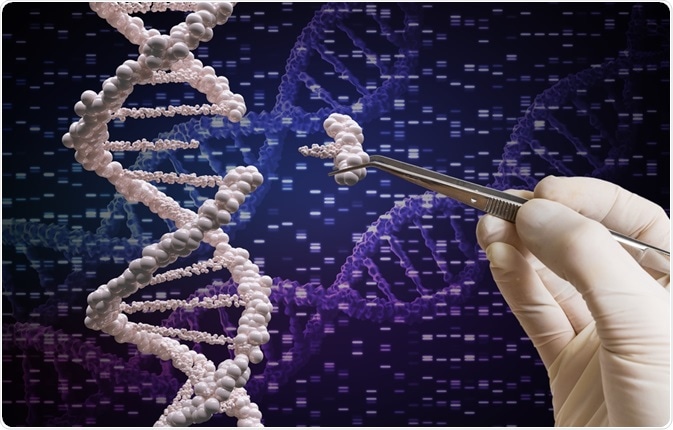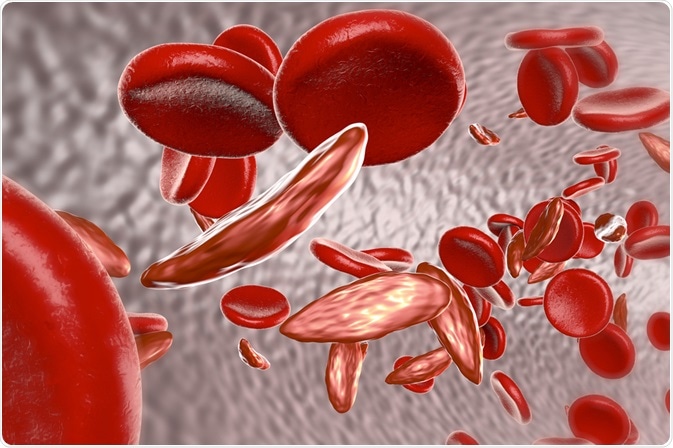Gene editing is making specific changes to nucleic acids such as DNAs and RNAs in an organism. With the current advances in developing gene-editing tools and applications, it is now possible to incorporate gene editing into our healthcare system and provide personalized, better healthcare to individuals.

Gene Editing. Image Credit: vchal/Shutterstock.com
What is gene editing?
Gene editing employs various methods to specifically edit, delete, or insert genes at specific locations on the genome. The most recently characterized system used for gene editing is the prokaryotic clustered regularly interspaced short palindromic repeats (CRISPR) and CRISPR-associated systems (Cas).
A type of CRISPR system, CRISPR-Cas9 allows directed targeting of specific DNA sequences and cutting of those sequences. After cutting the DNA strands, it also allows homologous recombination, a genome repair mechanism that inserts another DNA sequence into the location where the DNA strands were cut.
The CRISPR-Cas9 system is easy to engineer and tailor to different genes that need to be edited. It allows for the development of personalized medicine, which tailors treatments to each individual with the disease. Traditionally, medical treatments are the same for all individuals with the disease.
However, due to the different genetic backgrounds of patients, treatment effectiveness and side effects may be different for each patient. CRISPR-Cas9 provides targeted treatments and is cost-effective for mass-scale manufacturing in healthcare settings.
Gene editing in healthcare
In 2013, two studies by Cong et al. and Mali et al. have shown that CRISPR-Cas9 can be used for gene editing in mammalian cells. Since the publication of these two studies, it paves the way for developing a CRISPR-Cas9 system that can be used in vivo, that is, in living organisms.
Then in 2016, a group of scientists led by oncologist Lu You injected cells modified by CRISPR-Cas9 into a patient with aggressive lung cancer. They extracted immune cells from the patient’s blood and disabled a gene that cancer cells take advantage of to proliferate.
The edited cells are cultured, multiplied, and injected back into the patient. Although this trial is mainly for testing safety, it marks the first time of the usage of CRISPR-Cas systems in human beings.
In 2019, a patient with a genetically-inherited disease, sickle cell disease, was cured of the disease with CRISPR. Researchers used CRISPR to correct a mutation on the genome of red blood cell stem cells, correcting the morphology of the red blood cells derived from the stem cell. Primarily, the patient is cured of the disease but it needs to be monitored for a longer period to determine if the gene-editing curing effect is long-lasting and whether there are potential side effects.

Sickle Cell Anemia. Image Credit: Kateryna Kon/Shutterstock.com
Shortly after, the healthcare sector has been researching applications of the CRISPR-Cas system in curing other diseases. A mice model cured of the human immunodeficiency virus 1 (HIV-1) by a combination of existing antiretroviral therapy and CRISPR gene editing was introduced in 2020 and has shown a promising proof of concept.
Not only can CRISPR be used for disease treatment, but it can also be used as a diagnostic tool. With the ability of Cas proteins to target specific nucleic acid sequences, they can be programmed to detect signature nucleic acid sequences derived from viruses and bacteria.
An example of this is SHERLOCK (specific high-sensitivity enzymatic reporter unlocking), which involves sample amplification and CRISPR-based detection. CRISPR-based diagnostic tools are constantly being improved to be more streamlined and robust for rapid testing of diseases such as COVID-19.
Together, gene editing has shown great potential in providing personalized treatment for diseases in our healthcare system. With the right balance between safety tests and pioneer research, it paves the way for a better healthcare system and longer life expectancy.
References:
- Chu, V., Weber, T., Wefers, B. et al. Increasing the efficiency of homology-directed repair for CRISPR-Cas9-induced precise gene editing in mammalian cells. Nat Biotechnol 33, 543–548 (2015). https://doi.org/10.1038/nbt.3198
- Demirci, Selami, Leonard, Alexis, Haro-Mora, Juan J, Uchida, Naoya, & Tisdale, John F. (2019). CRISPR/Cas9 for Sickle Cell Disease: Applications, Future Possibilities, and Challenges. Cell Biology and Translational Medicine, Volume 5, 1144, 37-52.
- Katelyn Brinegar, Ali K. Yetisen, Sun Choi, Emily Vallillo, Guillermo U. Ruiz-Esparza, Anand M. Prabhakar, Ali Khademhosseini & Seok-Hyun Yun (2017) The commercialization of genome-editing technologies, Critical Reviews in Biotechnology, 37:7, 924-932, DOI: 10.1080/07388551.2016.1271768
- Mathur, S., & Mathur, S. (2017). Personalized medicine could transform healthcare (Review). Biomedical Reports, 7, 3-5. https://doi.org/10.3892/br.2017.922
- NIDA. 2020, February 14. Antiretroviral Therapy Combined With CRISPR Gene Editing Can Eliminate HIV Infection in Mice. Retrieved from https://www.drugabuse.gov/news-events/nida-notes/2020/02/antiretroviral-therapy-combined-crispr-gene-editing-can-eliminate-hiv-infection-in-mice on 2020, November 23
Further Reading
Last Updated: Jan 8, 2021